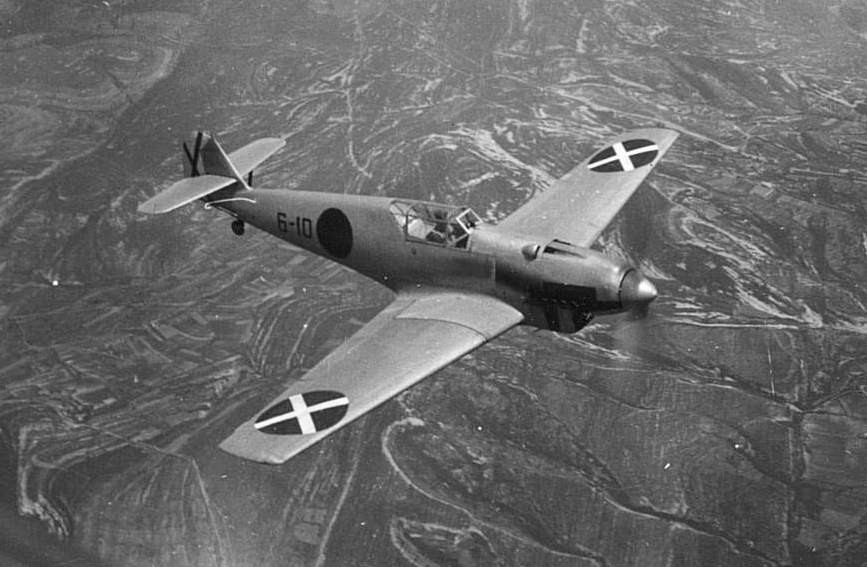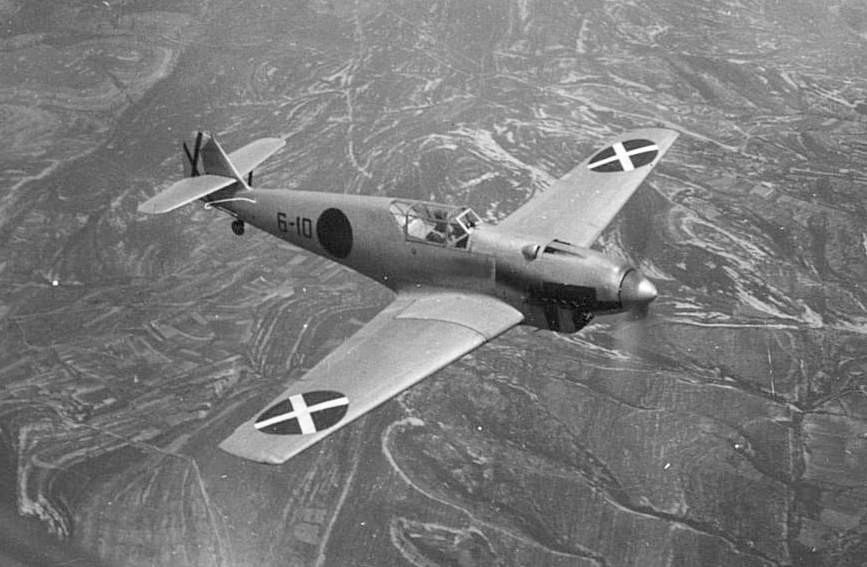

In the first of a series of articles presenting cases for the best fighter aircraft of World War II, we start with Jim Smith’s case for the Messerchmitt Bf 109. Let us know your thoughts in the comments section below.
The Messerschmitt Bf 109 was the greatest fighter of the Second World War.
A simple, bold statement, which many will question, based on their knowledge that other aircraft, in particular variants, were superior to particular variants of the Bf 109.
Nevertheless, if we look at the big picture, of duration in service, of numbers built, and of victories claimed, there can be little doubt that the Bf 109 deserves this accolade.
Firstly, the aircraft design ensured its initial success and immediate superiority. Messerschmitt combined all the available technologies of 1934 to design a stressed-skin, retractable undercarriage fighter with the smallest and lightest possible airframe, around the most powerful available engine. Sharing many of these features with its great rival, the Spitfire, Messerschmitt took advantage of wing leading edge slots, and slotted flaps to reduce wing size without compromising landing speed and controllability at low speeds.
The aircraft enjoyed an initial operational period of superiority over all its competitors, with no match in combat in Spain, or in the initial campaigns of the Second World War in Poland and in France, where its superiority over the Hurricane was evident. Air combat with its British match, the Spitfire, did not occur until May 1940, during the evacuation of Dunkirk.
Contemporary comparisons of the Bf 109E with the Mk 1 Spitfire showed these aircraft to be closely competitive in air combat, with the Spitfire offering greater manoeuvrability due to its lower wing loading, and the Messerschmitt slightly higher speed, a higher climb rate up to 20,000 ft, and the ability to disengage from air combat at will by diving away, thanks to its fuel-injected engine.

Secondly, continuous development kept the Bf 109 competitive with its opponents in the Western Theatre, and superior to its opposition in North Africa, and on the Eastern Front, at least until late in the war. Naturally, both the Spitfire and Messerschmitt were rapidly developed, each in an effort to out-perform their dangerous opponent, and this competitive development resulted in the Spitfire V, with two-stage supercharging, and cannon armament, appearing in 1941. The Bf 109 received extensive aerodynamic refinements and engine development, resulting in the Bf 109F, which came into service at about the same time as the Spitfire V.
Significant improvements to the Bf 109F included refinements to its cooling system, lowering drag, and improvements to flaps, slats and ailerons. The armament was revised to remove the wing-mounted cannon in favour of an engine mounted 20 mm cannon, and two fuselage-mounted 7.9mm machine guns. These changes improved both the manoeuvrability and climb rate of the aircraft, and later models incorporated Nitrous Oxide injection to increase power, and a variety of armament modifications.
The opening of hostilities against the Soviet Union in June 1941 involved large numbers of Bf 109E and Bf 109F aircraft, and resulted in very high numbers of kills of Soviet aircraft. Soviet losses by midday on the second day of the Operation Barbarossa campaign amounted to 1200 aircraft, of which slightly more than 800 were destroyed on the ground. The campaign on the Eastern Front presented the opportunity for experienced fighter pilots, flying the Bf 109 in conditions of air superiority against relatively poorly equipped and trained opposition, to score enormous numbers of kills.
This constitutes the third element in the case for the Bf 109 being the greatest fighter of the Second World War, and is illustrated by some compelling statistics. The top 3 fighter pilots of WW2, all flying Bf 109s on the Eastern Front, claimed a total of 928 victories, 352 falling to Erich Hartmann, 301 to Gerhard Barkhorn, and 275 to Günter Rall. In North Africa, Hans-Joachim Marseille accounted for 158 allied aircraft, and no less than 105 Bf 109 pilots claimed more than 100 aircraft kills.

Development of the Bf 109 continued, with the more powerful, heavier and faster Bf 109G, powered by the Daimler-Benz DB 605 engine. The Bf 109G was substantially heavier than earlier models, though, and the increased weight did impact on stability and control, handling qualities and manoeuvrability. Nonetheless, the Bf 109G became the most produced version of the aircraft and, when it entered service in April 1942, was superior to the Spitfire V, particularly when using Nitrous-oxide (GM-1) boost, which was fitted as standard.
While gradually supplemented, by the FW 190 in the West, large numbers of Bf 109G continued to serve on the Eastern and other fronts, and, from mid-1943, increasing use was made of the type as a reconnaissance aircraft, for ground attack, and as a night fighter.
Appearance of the Bf 109F and G, coupled with the entry to service of the Focke-Wulf 190, added urgency to the development of the Spitfire Mk IX, powered by the two-speed, two-stage supercharged Merlin 60, and this aircraft became operational with the RAF in July 1942.
The advent of the Spitfire IX, and from 1944, the P-51 Mustang, Griffon-powered Spitfire variants, and, in the East, the Lavochkin La-7 and Yak-3, placed the Bf 109 in a difficult position. Nevertheless, large numbers of aircraft continued to serve with the Luftwaffe, with the focus of their operations gradually shifting towards homeland defence as Allied forces advanced, following their successes in North Africa, in the invasion of France and Italy, and Soviet advances on the Eastern Front.
The final few months of the war essentially left the Luftwaffe in a defensive situation, with the Messerschmitt 109 now lacking performance against the best of the Allied fighters, and advanced aircraft like the Messerschmitt 262 only available in small numbers. All of the available fighters, principally Bf 109s and Focke-Wulf Fw 190s, were badly affected by logistical issues, particularly shortages of fuel and spare parts.

The fourth and final element of the case for the Bf 109 being the greatest fighter of the Second World War rests simply on the number built and its longevity in service. With continuous development from design initiation in 1934, through innumerable variations up to the end of the conflict in Europe, and beyond, the Bf 109 demonstrated both adaptability and longevity. Post-war variants came from Czechoslovakia with the Avia S-99 and developments, and from Spain, where the Hispano HA 1109 and ultimately the HA 1112 Buchon remained operational up to the end of 1965.
A total of 33,984 Messerschmitt Bf 109 were built, with additional production of about 600 Avia S-99/199 aircraft in Czechoslovakia, and a further 200 or so Hispano 1112 aircraft in Spain. Nearly 14,000 Bf 109G were manufactured in 1944 alone, and overall, Bf 109 production amounted to about a quarter of all aircraft built for the Luftwaffe. By comparison, production of the Spitfire, which also occurred throughout the conflict, amounted to 22,759 airframes.
The Bf 109 was the greatest fighter of the Second World War because:
- Its advanced design resulted in periods of superiority over its opponents, particularly for early variants in the Spanish Civil War, and for the Bf 109E, which was superior to all opposition up to May 1940, from which time the Spitfire 1 achieved broad parity with the Bf 109E;
- The aerodynamic and engine improvements introduced with the Bf 109F gave that aircraft superiority over the Spitfire V, over Allied fighters in the early part of the North Africa campaign, and over Soviet aircraft in the first year of the campaign on the Eastern Front;
- The number of victories claimed by Bf 109 pilots far exceeds the numbers achieved by pilots of any other aircraft, largely due to the superiority enjoyed by Luftwaffe pilots over Soviet aircraft and pilots on the Eastern Front, but also due to the aircraft’s successes in other Theatres;
- The number of aircraft produced and fielded exceeded that of all other military aircraft, with the exception of the Ilyushin Il 2 armoured attack aircraft. The Bf 109, like the Spitfire, was manufactured from before WW2 through to the end of hostilities and beyond. The final related version, the Merlin-engined Buchon, first flew in 1954, and was operational until the end of 1965, 30 years after the prototype Bf 109’s first flight.
Sources:
Warplanes of the Third Reich, William Green, 1970
Warplanes of the Second World War – Fighters Vol 1 & 2, William Green, 1960
Wings of Fame Volume 4: Messerschmitt Bf 109 early variants, David Donald, 1996
Wings of Fame Volume 11: Messerschmitt Bf 109: the later variants, David Donald, 1998
Wikipedia





